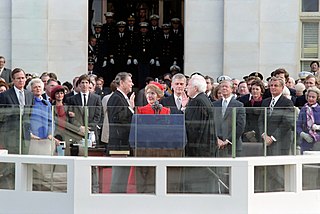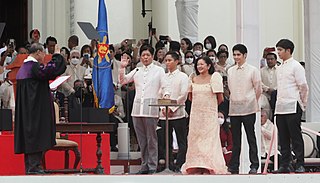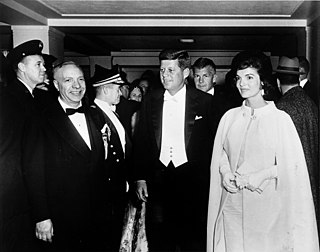
Ulysses S. Grant was an American military officer and politician who served as the 18th president of the United States from 1869 to 1877. As commanding general, Grant led the Union Army to victory in the American Civil War in 1865.

Between 73 and 79 days after the presidential election, the president-elect of the United States is inaugurated as president by taking the presidential oath of office. The inauguration takes place for each new presidential term, even if the president is continuing in office for a second term.

The first inauguration of Barack Obama as the 44th president of the United States took place on Tuesday, January 20, 2009, at the West Front of the United States Capitol in Washington, D.C. The 56th inauguration, which set a record attendance for any event held in the city, marked the commencement of the first term of Barack Obama as president and Joe Biden as vice president. Based on combined attendance numbers, television viewership, and Internet traffic, it was one of the most-observed events ever by the global audience at the time.

The inauguration of William Henry Harrison as the ninth president of the United States was held on Thursday, March 4, 1841, at the East Portico of the United States Capitol in Washington, D.C. This was the 14th inauguration and marked the commencement of the only four-year term of both William Henry Harrison as president and John Tyler as vice president. The presidential oath of office was administered to Harrison by Chief Justice Roger B. Taney. Harrison died 31 days into his term, the first U.S. president to die in office and has the shortest presidential term in American history. Tyler then succeeded to the presidency, creating a precedent which would be followed seven more times before it was officially regulated through the Twenty-fifth Amendment in 1967.

The first inauguration of Bill Clinton as the 42nd president of the United States was held on Wednesday, January 20, 1993, at the West Front of the United States Capitol in Washington, D.C. This was the 52nd inauguration and marked the commencement of the first term of Bill Clinton as president and Al Gore as vice president. At 46 years, 154 days of age at the time of his first inauguration, Clinton was the third-youngest person to become president, and the first from the Baby Boomer generation.

The first inauguration of George W. Bush as the 43rd president of the United States took place on Saturday, January 20, 2001, at the West Front of the United States Capitol in Washington, D.C. This was the 54th inauguration and marked the commencement of the first term of George W. Bush as president and Dick Cheney as vice president. Chief Justice William Rehnquist administered the presidential oath of office at 12:01 p.m., after he administered the vice presidential oath of office as well. An estimated 300,000 people attended the swearing-in ceremony. This was the first presidential inauguration to take place in the 21st century, and the first in the 3rd millennium.

The second inauguration of Ronald Reagan as president of the United States was held in a televised ceremony on January 20, 1985, at the White House, and was repeated the following day, January 21, 1985, at the Capitol's rotunda. This was the 50th presidential inauguration and marked the commencement of the second and final four-year term of both Ronald Reagan as president and of George H. W. Bush as vice president. At 73 years, 349 days of age on Inauguration Day, Reagan was the oldest U.S. president to be inaugurated, until Joe Biden's inauguration as president on January 20, 2021, at the age of 78 years, 61 days.

The first inauguration of Ronald Reagan as the 40th president of the United States was held on Tuesday, January 20, 1981, at the West Front of the United States Capitol in Washington, D.C. This was the first inauguration to be held on the building's west side. This was the 49th inauguration and marked the commencement of Ronald Reagan's and George H. W. Bush's first term as president and vice president, respectively. Chief Justice Warren E. Burger administered the presidential oath of office to Reagan, who placed his hand upon a family Bible given to him by his mother, open to 2 Chronicles 7:14. Associate Justice Potter Stewart administered the vice presidential oath to Bush.

The inauguration of Jimmy Carter as the 39th president of the United States was held on Thursday, January 20, 1977, at the East Portico of the United States Capitol in Washington D.C. This was the 48th inauguration and marked the commencement of Jimmy Carter's and Walter Mondale's single term as president and vice president. Chief Justice Warren E. Burger administered the presidential oath of office to Carter, and Speaker of the House Tip O'Neill administered the vice presidential oath of office to Mondale. This was the last inauguration held on the East Portico of the Capitol building as well as the last time the chief justice would stand to the left of the podium, with the audience facing them, while swearing in a president. Exactly forty years later, Carter attended the inauguration of Donald Trump, becoming the first U.S. president to mark the 40th anniversary of his inauguration.

The second inauguration of Harry S. Truman as president of the United States was held on Thursday, January 20, 1949, at the East Portico of the United States Capitol in Washington, D.C. This was the 41st inauguration and marked the commencement of the second and only full term of Harry S. Truman as president as well as the only term of Alben W. Barkley as vice president. Chief Justice Fred M. Vinson administered the presidential oath of office while Justice Stanley Forman Reed administered the vice-presidential oath of office.

The inauguration of William Howard Taft as the 27th president of the United States was held on Thursday, March 4, 1909, at the Senate chamber inside the United States Capitol, Washington, D.C., instead of the regular East Portico due to a blizzard. This was the 31st inauguration and marked the commencement of William Howard Taft's only term as president and James S. Sherman's only term as vice president.

The inauguration of Zachary Taylor as the 12th president of the United States was held on Monday, March 5, 1849, at the East Portico of the United States Capitol in Washington, D.C., and was the second instance of an inauguration being rescheduled due to March 4 falling on a Sunday, the Christian sabbath. This was the 16th regular inauguration and marked the commencement of the only four-year term of both Zachary Taylor as president and Millard Fillmore as vice president. Taylor died 1 year, 126 days into this term, and Fillmore succeeded to the presidency. The presidential oath of office was administered by Chief Justice Roger B. Taney. Inauguration Day started off being cloudy with snow flurries, but turned to heavy snow during the inaugural balls.

The inauguration of John F. Kennedy as the 35th president of the United States was held on Friday, January 20, 1961, at the East Portico of the United States Capitol in Washington, D.C. This was the 44th inauguration and marked the commencement of John F. Kennedy's and Lyndon B. Johnson's only term as president and vice president. Kennedy was assassinated 2 years, 306 days into this term, and Johnson succeeded to the presidency.

The first inauguration of Ulysses S. Grant as the 18th president of the United States was held on March 4, 1869, at the East Portico of the United States Capitol in Washington, D.C. This was the 21st presidential inauguration and marked the commencement of the first four-year term of Ulysses S. Grant as president and the only term of Schuyler Colfax as vice president. Chief Justice Salmon P. Chase administered the presidential oath of office. Outgoing president Andrew Johnson did not attend the inaugural ceremonies, as he and Grant refused to sit with each other in the carriage going to them. Johnson also refused to go in a separate carriage. Instead, he was in the White House signing last-minute legislation. This was the fourth time an outgoing president boycotted his elected successor's inauguration, an event that would not occur again until Donald Trump boycotted Joe Biden's inauguration in 2021 after failing to overturn the results.

The inauguration of the president of the Republic of the Philippines is a ceremony marking the commencement of the six-year term of a president of the Philippines, who is both head of state and head of government. The inauguration is performed on June 30, as mandated by the 1987 Constitution. Under the older 1935 Constitution, the date was December 30, which is also Rizal Day; the last inauguration held on the older date was Ferdinand Marcos' second one on December 30, 1969. The most recent public presidential inauguration ceremony was that of President Bongbong Marcos, who began his six-year term in office on Thursday, June 30, 2022.

United States presidential inaugural balls are large social gatherings, both white tie and black tie, held to celebrate the commencement of a new term of the president of the United States. Planned and sanctioned by the Presidential Inaugural Committee, the official inaugural balls occur throughout the evening of Inauguration Day in the Washington D.C. area and are invitation-only, attended by guests who are issued pre-paid tickets. The president, first lady, vice president, and second lady or gentleman all make personal appearances at each of the inaugural balls held in their honor. Catered food, beverages, and live entertainment performed by national and globally acclaimed musicians are provided at the inaugural balls.

The second inauguration of Barack Obama as the 44th president of the United States was the 57th inauguration, marking the commencement of his second and final term, with Joe Biden as vice president. A private swearing-in ceremony took place on Sunday, January 20, 2013, in the Blue Room of the White House, followed by a public inauguration ceremony on Monday, January 21, 2013, at the West Front of the United States Capitol in Washington, D.C.

Charles Julian Brotman is an American public relations specialist and public address announcer, known for his presentation of U.S. presidential inaugural parades of 12 presidents from Harry S. Truman to Joe Biden.

The inauguration of Donald Trump as the 45th president of the United States marked the commencement of Trump's term as president and Mike Pence's term as vice president. An estimated 300,000 to 600,000 people attended the public ceremony held on Friday, January 20, 2017, at the West Front of the United States Capitol in Washington, D.C. The event was the 58th presidential inauguration. Held in Washington, D.C., from January 17 to 21, 2017, inaugural events included concerts, the swearing-in ceremony, a congressional luncheon, parade, inaugural balls, and the interfaith inaugural prayer service. The inauguration was protested worldwide.

The inauguration of Joe Biden as the 46th president of the United States took place on Wednesday, January 20, 2021, on the West Front of the United States Capitol in Washington, D.C. It was the 59th inauguration and marked the commencement of the single term of Joe Biden as president and Kamala Harris as vice president. Biden took the presidential oath of office, before which Harris took the vice presidential oath of office.




















